Texas Wine Grape Varieties
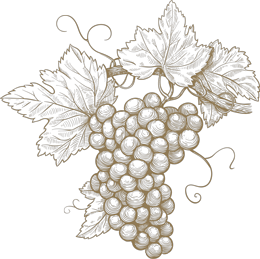
Texas has eight AVAs, although many vineyards exist outside the specified AVAs. For a wine to mention an AVA on the label, 85% of the volume of wine must come from grapes grown in that designated region.
Texas grape growers have learned what varieties do well in Texas climate and soil. Texans are proud to share their award-winning Texas wines made with Texas grapes.
Texas is the site of the first vineyard established in North America by Franciscan priests close to 1659. As European settlers followed the development of mission outposts, they brought more grapevine cuttings, further developing the industry through the 1800s.
Today, Texas boasts approximately 4,500 acres of producing vineyard farmland. The U.S. Department of Treasury, through the Alcohol and Tobacco Tax and Trade Bureau, officially designates American Viticulture (Grape Growing) Areas, or AVAs.
A viticultural area for American wine is a delimited grape-growing region having distinguishing features, a name, and delineated boundary. These designations allow vintners and consumers to attribute a given quality, reputation, or other characteristic of a wine made from grapes grown in an area to its geographic origin.
The establishment of viticultural areas allows vintners to describe more accurately the origin of their wines to consumers and helps consumers to identify wines they may purchase.
 Aglianico is a red wine grape variety native to southern Italy. It is known to produce full-bodied red wines that show musky berry flavors with firm tannins and good aging potential. Even when grown in hot climates, Aglianico is capable of reaching high levels of acidity, which makes it a particularly useful vine in the Mediterranean.
Aglianico is a red wine grape variety native to southern Italy. It is known to produce full-bodied red wines that show musky berry flavors with firm tannins and good aging potential. Even when grown in hot climates, Aglianico is capable of reaching high levels of acidity, which makes it a particularly useful vine in the Mediterranean.
In their youth, Aglianico wines tend to be very tannic and concentrated, especially if adverse weather conditions force producers to harvest their crop before it has achieved complete ripeness. A few years of aging has a favorable impact on the wine and helps the tannins to soften and the fruit profile to emerge. Aglianico wines are typically garnet-red, fading to terracotta tones after sufficient time in bottle.
Aglianico vines prefer warm, dry conditions, and therefore, the grape has been trialed in California and Riverina, Australia. It ripens late even in these warm climates, with the best examples offering aromas of chocolate and plum.
 Albariño is a green-skinned grape variety native to Galicia on the north Atlantic coast of Spain. It is best known as being the key grape variety in the Rias Baixas DO, where it makes plump white wines with peach, citrus, and mineral characters that pair perfectly with the local seafood.
Albariño is a green-skinned grape variety native to Galicia on the north Atlantic coast of Spain. It is best known as being the key grape variety in the Rias Baixas DO, where it makes plump white wines with peach, citrus, and mineral characters that pair perfectly with the local seafood.
The variety is high in acidity and can be produced as a light white wine or in a fuller style, with oak or lees aging adding to the texture and richness. A marine characteristic from the nearby Atlantic ocean is often discernible, sometimes manifesting itself as a slight salinity, which makes Albariño a perfect food wine.
 Alicante Bouschet or Alicante Henri Bouschet is a wine grape variety that has been widely cultivated since 1866. It is a cross of Petit Bouschet and Grenache. Alicante is a teinturier, a grape with red flesh. Its deep color makes it useful for blending with light red wine.
Alicante Bouschet or Alicante Henri Bouschet is a wine grape variety that has been widely cultivated since 1866. It is a cross of Petit Bouschet and Grenache. Alicante is a teinturier, a grape with red flesh. Its deep color makes it useful for blending with light red wine.
At the turn of the 21st century, Alicante Bouschet was the 12th most planted red wine grape in France with sizable plantings in the Languedoc, Provence, and Cognac regions. In 1958, Alicante Bouschet covered 24,168 hectares (mainly across southern France); by 2011, plantings represented less than 4,000 hectares. This scenario is largely reversed in other regions of Europe, and in southern Portugal, where its wines are highly prized and frequently outscore traditional indigenous varieties
 Chambourcin is a purple-skinned, French-American hybrid grape that is more readily available in the United States and Australia than in its homeland, France. It is one of the world’s most popular hybrid varieties and is noted for its distinctive dark coloring and herbaceous aroma. Chambourcin wines are often spicy, with black cherry and plum flavors, and a range of herbal characters.
Chambourcin is a purple-skinned, French-American hybrid grape that is more readily available in the United States and Australia than in its homeland, France. It is one of the world’s most popular hybrid varieties and is noted for its distinctive dark coloring and herbaceous aroma. Chambourcin wines are often spicy, with black cherry and plum flavors, and a range of herbal characters.
 Chenin Blanc is used to make white wine and most often used for blending. Typically dryer than chardonnay, it is less known by consumers and thus more difficult to find on winery lists. Tight clusters make the grape prone to bunch/sour rot and it is also susceptible to Pierce’s Disease. The grape does well in most parts of the state.
Chenin Blanc is used to make white wine and most often used for blending. Typically dryer than chardonnay, it is less known by consumers and thus more difficult to find on winery lists. Tight clusters make the grape prone to bunch/sour rot and it is also susceptible to Pierce’s Disease. The grape does well in most parts of the state.

Cinsaut, or Cinsault, is a red wine grape, whose heat tolerance and productivity makes it important in Languedoc-Roussillon and the former French colonies of Algeria, Lebanon, and Morocco. It is often blended with grapes such as Grenache and Carignan to add softness and bouquet.
 The Concord grape is a cultivar derived from the grape species Vitis labrusca (also called fox grape) that are used as table grapes, wine grapes, and juice grapes. They are often used to make grape jelly, grape juice, grape pies, grape-flavored soft drinks, and candy. The grape is sometimes used to make wine, particularly kosher wine. Traditionally, most commercially produced Concord wines have been finished sweet, but dry versions are possible if adequate fruit ripeness is achieved.
The Concord grape is a cultivar derived from the grape species Vitis labrusca (also called fox grape) that are used as table grapes, wine grapes, and juice grapes. They are often used to make grape jelly, grape juice, grape pies, grape-flavored soft drinks, and candy. The grape is sometimes used to make wine, particularly kosher wine. Traditionally, most commercially produced Concord wines have been finished sweet, but dry versions are possible if adequate fruit ripeness is achieved.
The skin of a Concord grape is typically dark blue or purple and often is covered with a lighter colored epicuticular wax “bloom” that can be rubbed off. It is a slip-skin variety, meaning that the skin is easily separated from the fruit. Concord grapes have large seeds and are highly aromatic. The Concord grape is particularly prone to the physiological disorder Black leaf.
 Dolcetto is a black Italian wine grape variety widely grown in the Piedmont region of northwest Italy. The Italian word dolcetto means “little sweet one,” but it is not certain that the name originally carried any reference to the grape’s sugar levels. It is possible that it is derived from the name of the hills where the vine is cultivated. The wines produced by dolcetto grapes are nearly always dry. They can be tannic and fruity with moderate or decidedly low levels of acidity and are typically meant to be consumed within a few years after release.
Dolcetto is a black Italian wine grape variety widely grown in the Piedmont region of northwest Italy. The Italian word dolcetto means “little sweet one,” but it is not certain that the name originally carried any reference to the grape’s sugar levels. It is possible that it is derived from the name of the hills where the vine is cultivated. The wines produced by dolcetto grapes are nearly always dry. They can be tannic and fruity with moderate or decidedly low levels of acidity and are typically meant to be consumed within a few years after release.
 Gewürztraminer is an aromatic wine grape variety used in white wines and performs best in cooler climates. Gewürztraminer is a variety with a pink to red skin color, which makes it a “white wine grape” as opposed to the blue to black-skinned varieties commonly referred to as “red wine grapes.” The variety has high natural sugar, and the wines are white and usually off-dry, with a flamboyant bouquet of lychees. Dry Gewürztraminers may also have aromas of roses, passion fruit, and floral notes.
Gewürztraminer is an aromatic wine grape variety used in white wines and performs best in cooler climates. Gewürztraminer is a variety with a pink to red skin color, which makes it a “white wine grape” as opposed to the blue to black-skinned varieties commonly referred to as “red wine grapes.” The variety has high natural sugar, and the wines are white and usually off-dry, with a flamboyant bouquet of lychees. Dry Gewürztraminers may also have aromas of roses, passion fruit, and floral notes.
 Graciano is a Spanish red wine grape that is grown primarily in Rioja. The vine produces a low yield that are normally harvested in late October. The wine produced is characterized by its deep red color, strong aroma, and ability to age well. Graciano thrives in warm, arid climates.
Graciano is a Spanish red wine grape that is grown primarily in Rioja. The vine produces a low yield that are normally harvested in late October. The wine produced is characterized by its deep red color, strong aroma, and ability to age well. Graciano thrives in warm, arid climates.
 Grenache is one of the most widely planted red wine grape varieties in the world. It ripens late, so it needs hot, dry conditions, such as those found in Spain, where the grape most likely originated.
Grenache is one of the most widely planted red wine grape varieties in the world. It ripens late, so it needs hot, dry conditions, such as those found in Spain, where the grape most likely originated.
It is generally spicy, berry flavored, and soft on the palate, and produces wine with a relatively high alcohol content, but it needs careful control of yields for best results. Characteristic flavor profiles on Grenache include red fruit flavors (raspberry and strawberry) with a subtle, white pepper spice note. Grenache wines are highly prone to oxidation, with even young examples having the potential to show browning (or “bricking”) coloration that can be noticed around the rim when evaluating the wine at an angle in the glass. As Grenache ages the wines tend to take on more leather and tar flavors. Wines made from Grenache tend to lack acid, tannin, and color, and it is often blended with other varieties, such as Syrah, Carignan, Tempranillo, and Cinsaut.
 Lomanto is a Pierce’s Disease (PD) tolerant red wine grape cultivar that was developed by T.V. Munson in 1902. Lomanto resulted from a cross between the hybrid grape cultivar Salado and Pense. Pense is a synonym for the European grape (Vitis vinif-era) cultivar Malaga, meaning that Lomanto is presumably at least 50% Vitis vinifera. Lomanto is grown commercially on a small scale in Texas as a wine grape and is frequently grown as a backyard grape due to its disease resistance and high-quality potential.
Lomanto is a Pierce’s Disease (PD) tolerant red wine grape cultivar that was developed by T.V. Munson in 1902. Lomanto resulted from a cross between the hybrid grape cultivar Salado and Pense. Pense is a synonym for the European grape (Vitis vinif-era) cultivar Malaga, meaning that Lomanto is presumably at least 50% Vitis vinifera. Lomanto is grown commercially on a small scale in Texas as a wine grape and is frequently grown as a backyard grape due to its disease resistance and high-quality potential.
 Malvasia, one of Italy’s most widely planted grapes, has its origins in ancient Greece. Malvasia Bianca, a white grape, is the most common variety, although there is red Malvasia as well. White Malvasia grapes make smooth and lightly viscous wines, aromatic and with notes of tropical fruits, that can be dry or sweet. In central Italy, Malvasia Bianca has traditionally been added to both white and red wine blends to boost body and flavor.
Malvasia, one of Italy’s most widely planted grapes, has its origins in ancient Greece. Malvasia Bianca, a white grape, is the most common variety, although there is red Malvasia as well. White Malvasia grapes make smooth and lightly viscous wines, aromatic and with notes of tropical fruits, that can be dry or sweet. In central Italy, Malvasia Bianca has traditionally been added to both white and red wine blends to boost body and flavor.
The white Malvasia variety is also used in sweet fortified Madeira wines, from Portugal, known as Malmsey. It’s also grown in France, Greece, and California.
Marsanne is a white wine grape, most commonly found in the Northern Rhône region. It is often blended with Roussanne. In Savoie the grape is known as grosse roussette. Outside France it is also grown in Switzerland (where it is known as ermitage blanc or just ermitage), Spain, Australia, New Zealand, Canada, and the United States.
Vitis mustangensis, commonly known as the mustang grape, is a species of grape that is native to the southern United States. Its range includes parts of Mississippi, Alabama, Louisiana, Texas, and Oklahoma.
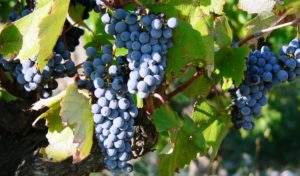 Negroamaro is a dark-skinned grape variety that has been associated with the Puglia region in southern Italy for at least 1,500 years. Most commonly found in a blend, alongside Primitivo, Malvasia Nera, Sangiovese, or Montepulciano, Negroamaro is valued for its deep color, medium-full tannins, and dark berryfruit flavors. The variety can also add earthen tones that can cross over into slightly medicinal flavors. It is mildly aromatic and can produce complex wines that show characteristics of ground brown spices, such as clove, cinnamon, and allspice.
Negroamaro is a dark-skinned grape variety that has been associated with the Puglia region in southern Italy for at least 1,500 years. Most commonly found in a blend, alongside Primitivo, Malvasia Nera, Sangiovese, or Montepulciano, Negroamaro is valued for its deep color, medium-full tannins, and dark berryfruit flavors. The variety can also add earthen tones that can cross over into slightly medicinal flavors. It is mildly aromatic and can produce complex wines that show characteristics of ground brown spices, such as clove, cinnamon, and allspice.
 This grape is used in making dry wine. This varietal closely resembles Norton, but many will say Cynthiana should be considered a separate varietal. Genetic studies show the two varietals are almost indistinguishable. Maybe Cynthiana is a mutation of the original Norton.
This grape is used in making dry wine. This varietal closely resembles Norton, but many will say Cynthiana should be considered a separate varietal. Genetic studies show the two varietals are almost indistinguishable. Maybe Cynthiana is a mutation of the original Norton.
 Pinot gris, pinot grigio, or Grauburgunder is a white wine grape variety of the species Vitis vinifera. Thought to be a mutant clone of the pinot noir variety, it normally has a grayish-blue fruit, accounting for its name, but the grapes can have a brownish pink to black and even white appearance. The word pinot could have been given to it because the grapes grow in small pine cone-shaped clusters. The wines produced from this grape also vary in color, from a deep golden yellow to copper and even a light shade of pink, and it is one of the more popular grapes for skin-contact wine.
Pinot gris, pinot grigio, or Grauburgunder is a white wine grape variety of the species Vitis vinifera. Thought to be a mutant clone of the pinot noir variety, it normally has a grayish-blue fruit, accounting for its name, but the grapes can have a brownish pink to black and even white appearance. The word pinot could have been given to it because the grapes grow in small pine cone-shaped clusters. The wines produced from this grape also vary in color, from a deep golden yellow to copper and even a light shade of pink, and it is one of the more popular grapes for skin-contact wine.
Pinot gris is grown around the globe with the “spicy” full-bodied Alsatian and lighter-bodied, more acidic Italian styles being most widely recognized. The Alsatian style, often duplicated in New World wine regions such as Marlborough, Tasmania, South Australia, Washington, and Oregon, tend to have moderate to low acidity, higher alcohol levels and an almost “oily” texture that contributes to the full-bodied nature of the wine. The flavors can range from ripe tropical fruit notes of melon and mango to some botrytis-influenced flavors. In Italy, Pinot grigio grapes are often harvested early to retain the refreshing acidity and minimize some of the overt-fruitiness of the variety, creating a more neutral flavor profile.

Ruby Cabernet is a red Olmo grape variety that is a cross between Cabernet Sauvignon and Carignan. It can produce wines with good color and a pleasant cherry flavor, but it is mostly blended into bulk wines.
The purpose for the creation of the crossing of the grape varieties utilized to produce Ruby Cabernet was to obtain the superior quality of a Cabernet wine, and the resistance to heat of the Carignan combined in an inexpensive table wine. Even though the wine made from these grapes does not possess the distinctive flavor and the overall structure of other types of Cabernet wines, it does carry their fruitful essence.
The grape for this type of red wine was developed for California’s hot climate, specially for regions such as the San Joaquin and the Napa Valleys. Ruby Cabernet has improved the quality of the bulk wines produced in these areas thanks to its natural, special acidity.
Along with Sauvignon blanc and Muscadelle, Sémillon is one of only three approved white wine varieties in the Bordeaux region. The grape is also key to the production of sweet wines such as Sauternes.
Touriga Nacional is a dark-skinned grape variety that is currently very fashionable and is widely believed to produce the finest red wines of Portugal. Extensively planted in the Portugal’s northern Dao and Douro wine regions, the variety is a key ingredient in both dry red wines and the fortified wines of Oporto (Port).
Trebbiano is the second most widely planted grape in the world. It gives good yields, but it makes undistinguished wine at best. It can be fresh and fruity, but it doesn’t keep long. Its high acidity makes it important in Cognac production.
Vermentino is a light-skinned wine grape variety, primarily found in Italian wine. It is widely planted in Sardinia, in Liguria primarily under the name Pigato, to some extent in Corsica, in Piedmont under the name Favorita, and in increasing amounts in Languedoc-Roussillon. The leaves are dark green and pentagonal.
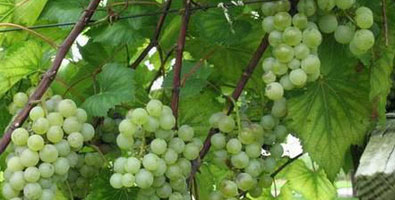 An American hybrid with Italian Muscat in its heritage. Primarily grown in Southeast Texas, this grape produces wine with high marketability. It is popular among grape growers for its resistance to Pierce’s Disease—a fatal bacterial disease that can affect an entire vineyard. Blanc du Bois is typically used to make white table wine. Pictures compliments of Grohmann Farms Vineyard, Weimar, TX
An American hybrid with Italian Muscat in its heritage. Primarily grown in Southeast Texas, this grape produces wine with high marketability. It is popular among grape growers for its resistance to Pierce’s Disease—a fatal bacterial disease that can affect an entire vineyard. Blanc du Bois is typically used to make white table wine. Pictures compliments of Grohmann Farms Vineyard, Weimar, TX
 Black Spanish is now known to be a seedling of an American hybrid grape resulting from a cross of the American Vitis aestivalis species of grape with an unknown Vitis vinifera pollen donor. This hybridization is not known to have been purposeful and may have occurred naturally, as was the case with many of the early American grape cultivars.
Black Spanish is now known to be a seedling of an American hybrid grape resulting from a cross of the American Vitis aestivalis species of grape with an unknown Vitis vinifera pollen donor. This hybridization is not known to have been purposeful and may have occurred naturally, as was the case with many of the early American grape cultivars.
The original American hybrid grape parent had found its way to the Madeira Islands early in the 18th century (where it was called Jaquez or Jacquet) and thence to France. Lenoir is another such seedling similar to Black Spanish, which was propagated by Herbemont.
Today, Lenoir is gaining favor among vineyards and wineries in the Texas Hill Country, the Rio Grande Valley, and in North Texa,s where Pierce’s Disease is a constant worry with vinifera grapes. A more disease-resistant, black-skinned, red-wine hybrid of Lenoir crossed with Herbemont called “Favorite” was bred by John Niederauer of Brenham, Texas, and introduced circa 1938 (Brooks & Olmo 3rd, 1997). As growers in Texas realize the risk and expense associated with growing vinifera grapes in an hostile environment, Lenoir and Favorite are gaining greater acceptance.
Lenoir has been used for years in Texas port-style wines and as a blending varietal for its earthy aroma and dark color. Only now are more wineries starting to use it in single-variety dry wines. Its taste has been described as completely different from European varieties, yet without the Concord-like notes of other old-line American hybrid grape varieties bred as table grapes from the wild Vitis labrusca grape. Also, the taste of Lenoir wine is said to improve when the bottle is left uncorked or strongly aerated by decanting, which suggests that reducing compounds are common in wines from the variety. Like the Virginia Vitis aestivalis hybrid Norton, Lenoir is gaining favor among wine enthusiasts who are looking for new tastes and locally sourced American products.
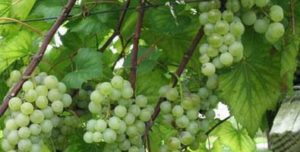 The king of red wine grapes does well over much of Texas, but especially well above 3,000 feet in elevation. Excellent wines made from this grape have been made by many Texas wineries and enjoyed by many consumers of Texas wines. Picture compliments of Williams Ranch Vineyard and Kirk Williams in San Antonio, TX.
The king of red wine grapes does well over much of Texas, but especially well above 3,000 feet in elevation. Excellent wines made from this grape have been made by many Texas wineries and enjoyed by many consumers of Texas wines. Picture compliments of Williams Ranch Vineyard and Kirk Williams in San Antonio, TX.
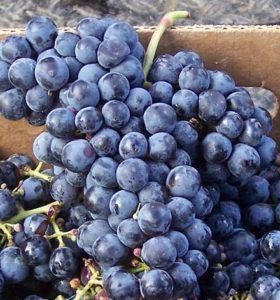 This classic French variety has does best on the South Plains or in extreme North Texas.
This classic French variety has does best on the South Plains or in extreme North Texas.
Cabernet Franc is one of the major black grape varieties worldwide. It is principally grown for blending with Cabernet Sauvignon and Merlot in the Bordeaux style, but can also be vinified alone, as in the Loire’s Chinon. In addition to being used in blends and produced as a varietal in Canada and the United States, it is sometimes made into ice wine in those regions.
Cabernet Franc is lighter than Cabernet Sauvignon, making a bright pale red wine that contributes finesse and lends a peppery perfume to blends with more robust grapes. Depending on the growing region and style of wine, additional aromas can include tobacco, raspberry, bell pepper, cassis, and violets.
Records of Cabernet Franc in Bordeaux go back to the end of the 18th century, although it was planted in Loire long before that time. DNA analysis indicates that Cabernet Franc is one of two parents of Cabernet Sauvignon, Merlot, and Carménère.
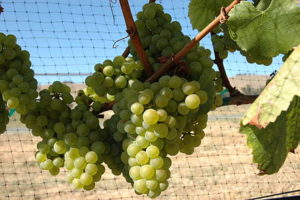 Chardonnay makes white wine. This grape is challenging to grow for much of Texas because it buds out early in the season, which makes the grapes subject to late spring freezes. Widespread recognition among consumers places this wine on most winery lists. It is susceptible to Pierce’s Disease. Wine from chardonnay grapes is typically aged for 12–13 months.
Chardonnay makes white wine. This grape is challenging to grow for much of Texas because it buds out early in the season, which makes the grapes subject to late spring freezes. Widespread recognition among consumers places this wine on most winery lists. It is susceptible to Pierce’s Disease. Wine from chardonnay grapes is typically aged for 12–13 months.
Chardonnay is a green-skinned grape variety used in the production of white wine. The variety originated in the Burgundy wine region of eastern France, but is now grown wherever wine is produced, from England to New Zealand. For new and developing wine regions, growing Chardonnay is seen as a “rite of passage” and an easy entry into the international wine market.
The Chardonnay grape itself is neutral, with many of the flavors commonly associated with the wine being derived from such influences as terroir and oak. It is vinified in many different styles, from the lean, crisply mineral wines of Chablis, France, to New World wines with oak and tropical fruit flavors. In cool climates (such as Chablis and the Carneros AVA of California), Chardonnay wine tends to be medium to light body with noticeable acidity and flavors of green plum, apple, and pear. In warmer locations (such as the Adelaide Hills and Mornington Peninsula in Australia and Gisborne and Marlborough region of New Zealand), the flavors become more citrus, peach, and melon, while in very warm locations (such as the Central Coast AVA of California), more fig and tropical fruit notes such as banana and mango come out. Wines that have gone through malolactic fermentation tend to have softer acidity and fruit flavors with buttery mouthfeel and hazelnut notes.
Chardonnay is an important component of many sparkling wines around the world, including Champagne and Franciacorta in Italy.
Chardonnay’s popularity peaked in the late 1980s, then gave way to a backlash among those wine connoisseurs who saw the grape as a leading negative component of the globalization of wine. Nonetheless, it is one of the most widely planted grape varieties, with 210,000 hectares (520,000 acres) worldwide, second only to Airén among white wine grapes and fifth among all wine grapes.
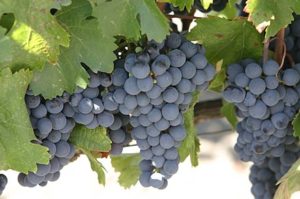 Malbec (pronounced [mal.bɛk]) is a purple grape variety used in making red wine. The grapes tend to have an inky dark color and robust tannins, and are known as one of the six grapes allowed in the blend of red Bordeaux wine. The French plantations of Malbec are now found primarily in Cahors in South West France. It is increasingly celebrated as an Argentine varietal wine and is being grown around the world.
Malbec (pronounced [mal.bɛk]) is a purple grape variety used in making red wine. The grapes tend to have an inky dark color and robust tannins, and are known as one of the six grapes allowed in the blend of red Bordeaux wine. The French plantations of Malbec are now found primarily in Cahors in South West France. It is increasingly celebrated as an Argentine varietal wine and is being grown around the world.
Called Malbec in Bordeaux, Auxerrois or Côte Noir in Cahors, and Pressac in other places, the grape became less popular in Bordeaux after 1956 when frost killed off 75% of the crop. Despite Cahors being hit by the same frost, which devastated the vineyards, Malbec was replanted and continued to be popular in that area where it was mixed with Merlot and Tannat to make dark, full-bodied wines, and more recently has been made into 100% Malbec varietal wines.
A popular but unconfirmed theory claims that Malbec is named after a Hungarian peasant who first spread the grape variety throughout France. However the French ampelographer and viticulturalist Pierre Galet notes that most evidence suggest that Côt was the variety’s original name and that it probably originated in northern Burgundy.Despite a similar name, the grape Malbec argenté is not Malbec, but rather a variety of the southwestern French grape Abouriou. Due to the similarities in synonyms, Malbec has also been confused with Auxerrois blanc, which is an entirely different variety.
The Malbec grape is a thick-skinned grape and needs more sun and heat than either Cabernet Sauvignon or Merlot to mature. It ripens mid-season and can bring very deep color, ample tannin, and a particular plum-like flavor component to add complexity to claret blends. Sometimes, especially in its traditional growing regions, it is not trellised and cultivated as bush vines (the goblet system). Here it is sometimes kept to a relatively low yield of about 6 tons per hectare. The wines are rich, dark, and juicy.
As a varietal, Malbec creates a rather inky red (or violet), intense wine, so it is also commonly used in blends, such as with Merlot and Cabernet Sauvignon to create the red French Bordeaux claret blend. The grape is blended with Cabernet Franc and Gamay in some regions such as the Loire Valley. Other wine regions use the grape to produce Bordeaux-style blends. The varietal is sensitive to frost and has a proclivity to shatter or coulure.
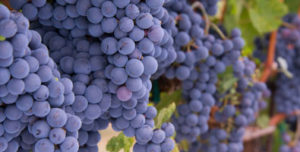 Merlot is a dark blue-colored wine grape variety that is used as both a blending grape and for varietal wines. The name Merlot is thought to be a diminutive of merle, the French name for the blackbird, probably a reference to the color of the grape. Its softness and “fleshiness,” combined with its earlier ripening, makes Merlot a popular grape for blending with the sterner, later-ripening Cabernet Sauvignon, which tends to be higher in tannin.
Merlot is a dark blue-colored wine grape variety that is used as both a blending grape and for varietal wines. The name Merlot is thought to be a diminutive of merle, the French name for the blackbird, probably a reference to the color of the grape. Its softness and “fleshiness,” combined with its earlier ripening, makes Merlot a popular grape for blending with the sterner, later-ripening Cabernet Sauvignon, which tends to be higher in tannin.
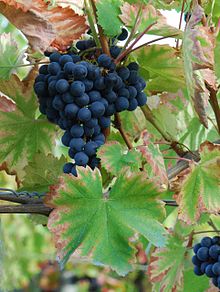 Mourvèdre (also known as Mataró or Monastrell) is a red wine grape variety that is grown in many regions around the world, including the Rhône and Provence regions of France, the Valencia and Jumilla denominaciones de origen of Spain, as well as the Balearic Islands, California and Washington, and the Australian regions of South Australia and New South Wales, as well as South Africa. In addition to making red varietal wines, Mourvèdre is a prominent component in “GSM” (Grenache, Syrah, and Mourvèdre) blends. The variety is also used to make rosé and port-style fortified wines.
Mourvèdre (also known as Mataró or Monastrell) is a red wine grape variety that is grown in many regions around the world, including the Rhône and Provence regions of France, the Valencia and Jumilla denominaciones de origen of Spain, as well as the Balearic Islands, California and Washington, and the Australian regions of South Australia and New South Wales, as well as South Africa. In addition to making red varietal wines, Mourvèdre is a prominent component in “GSM” (Grenache, Syrah, and Mourvèdre) blends. The variety is also used to make rosé and port-style fortified wines.
Mourvèdre tends to produce tannic wines that can be high in alcohol. The style of wine produced from the grapes varies greatly according to where it is produced, but according to wine expert Jancis Robinson Mourvèdre, wines often have wild game, or earthy notes to them, with soft red fruit flavors. According to wine expert Oz Clarke, young Mourvèdre can come across as faulted due to the reductive, sulfur notes and “farmyard-y” flavors that some wines can exhibit before those flavors mellow with age.
The variety can be a difficult grape to grow, preferring “its face in the hot sun and its feet in the water,” meaning that it needs very warm weather, a low leaf-to-fruit ratio, but adequate water or irrigation to produce intensely flavored fruit that is not overly jammy or herbaceous. The vines’ susceptibility to many viticultural hazards, such as powdery and downy mildew, as well as overly vigorous foliage can present additional problems for vine growers.
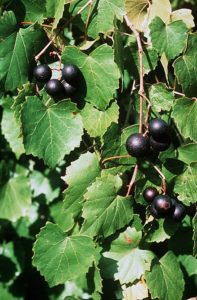 Vitis rotundifolia, or muscadine, is a grapevine species native to the southeastern and south-central United States from Florida to Delaware, west to eastern Texas and Oklahoma. It has been extensively cultivated since the 16th century. The plants are well adapted to their native warm and humid climate; they need fewer chilling hours than better known varieties and they thrive on summer heat.
Vitis rotundifolia, or muscadine, is a grapevine species native to the southeastern and south-central United States from Florida to Delaware, west to eastern Texas and Oklahoma. It has been extensively cultivated since the 16th century. The plants are well adapted to their native warm and humid climate; they need fewer chilling hours than better known varieties and they thrive on summer heat.
Muscadine berries may be bronze or dark purple or black when ripe. However, many wild varieties stay green through maturity. Muscadines have skin sufficiently thick and tough that eating the raw fruit is similar to eating a plum and may be an acquired taste. Muscadines are typically used in making artisan wines, juice, and jelly. They are rich sources of polyphenols.
In a natural setting, muscadines are important plants for improving wildlife habitat by providing cover, browse, and fruit for a wide variety of animals.
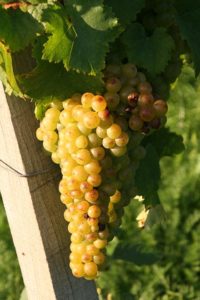 Muscat Blanc à Petits Grains is a white wine grape of Greek origin that is a member of the Muscat family of Vitis vinifera. Its name comes from its characteristic small berry size and tight clusters. It is known under a variety of local names such as Moscato bianco, Muscat blanc, Muscat Canelli, Muscat de Frontignan, Muscat de Lunel, Muscat d’Alsace, Muskateller, Moscatel de Grano Menudo, Moscatel rosé, and Sárgamuskotály .
Muscat Blanc à Petits Grains is a white wine grape of Greek origin that is a member of the Muscat family of Vitis vinifera. Its name comes from its characteristic small berry size and tight clusters. It is known under a variety of local names such as Moscato bianco, Muscat blanc, Muscat Canelli, Muscat de Frontignan, Muscat de Lunel, Muscat d’Alsace, Muskateller, Moscatel de Grano Menudo, Moscatel rosé, and Sárgamuskotály .
While technically a white grape, there are strains of Muscat Blanc à Petits Grains vines that produce berries that are pink or reddish brown. The same vine could potentially produce berries of one color one year and a different color the next. These strains are more prevalent in Australia, where the grape is also known as Frontignac and Brown Muscat. South Africa’s Muskadel strain tends to show the same darker characteristics. Variants where the differing grape colour is stable are typically classified as separate grape varieties Muscat Rouge à Petit Grains for red skin colour and Muscat Rose à Petit Grains for pink skin colour.
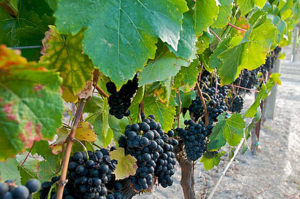 Petit Verdot is a variety of red wine grape, principally used in classic Bordeaux blends. It ripens much later than the other varieties in Bordeaux, often too late, so it fell out of favor in its home region. When it does ripen it adds tannin, color, and flavor, in small amounts, to the blend. Petit verdot has attracted attention among winemakers in the New World, where it ripens more reliably and has been made into single varietal wine. It is also useful in “stiffening” the mid palate of Cabernet Sauvignon blends.
Petit Verdot is a variety of red wine grape, principally used in classic Bordeaux blends. It ripens much later than the other varieties in Bordeaux, often too late, so it fell out of favor in its home region. When it does ripen it adds tannin, color, and flavor, in small amounts, to the blend. Petit verdot has attracted attention among winemakers in the New World, where it ripens more reliably and has been made into single varietal wine. It is also useful in “stiffening” the mid palate of Cabernet Sauvignon blends.
When young its aromas have been likened to banana and pencil shavings. Strong tones of violet and leather develop as it matures.
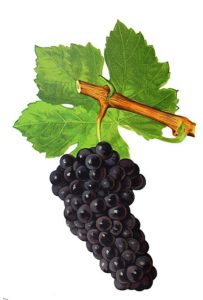 Durif is a variety of red wine grape primarily grown in Australia, California, France, and Israel. Since the end of the 20th century, wineries located in Washington’s Yakima River Valley, Maryland, Arizona, West Virginia, Chile, Mexico’s Baja California Peninsula, and Ontario’s Niagara Peninsula have also produced wines from Durif grapes.
Durif is a variety of red wine grape primarily grown in Australia, California, France, and Israel. Since the end of the 20th century, wineries located in Washington’s Yakima River Valley, Maryland, Arizona, West Virginia, Chile, Mexico’s Baja California Peninsula, and Ontario’s Niagara Peninsula have also produced wines from Durif grapes.
It is the main grape known in the U.S. and Israel as Petite Sirah, with more than 90% of the California plantings labeled “Petite Sirah” being Durif grapes; the U.S. Bureau of Alcohol, Tobacco, Firearms and Explosives (ATF) recognizes “Durif” and “Petite Sirah” as synonyms for the same grape. It produces tannic wines with a spicy, plummy flavour. The grape originated as a cross of Syrah pollen germinating a Peloursin plant. On some occasions, Peloursin and Syrah vines may be called Petite Sirah, usually because the varieties are extremely difficult to distinguish in old age.
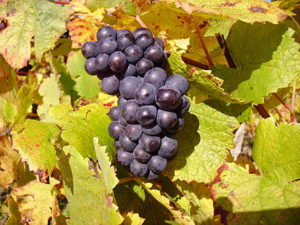 Pinot noir (French: [pino nwaʁ]) is a red wine grape variety of the species Vitis vinifera. The name may also refer to wines created predominantly from pinot noir grapes. The name is derived from the French words for pine and black. The word pine alludes to the grape variety having tightly clustered, pine cone-shaped bunches of fruit.
Pinot noir (French: [pino nwaʁ]) is a red wine grape variety of the species Vitis vinifera. The name may also refer to wines created predominantly from pinot noir grapes. The name is derived from the French words for pine and black. The word pine alludes to the grape variety having tightly clustered, pine cone-shaped bunches of fruit.
Pinot noir grapes are grown around the world, mostly in the cooler climates, and the grape is chiefly associated with the Burgundy region of France. Pinot noir is now used to make red wines around the world, as well as Champagne, and such sparkling white wines as the Italian Franciacorta, and English sparkling wines. Regions that have gained a reputation for red pinot noir wines include: the Willamette Valley of Oregon; the Carneros, Central Coast, and Russian River AVAs of California; the Elgin and Walker Bay wine regions of South Africa; Mornington Peninsula, Adelaide Hills, Great Southern, Tasmania, and Yarra Valley in Australia; and the Central Otago, Martinborough, and Marlborough wine regions of New Zealand. Pinot Noir is the most-planted varietal (38%) used in sparkling wine production in Champagne and other wine regions.
Pinot noir is a difficult variety to cultivate and transform into wine. The grape’s tendency to produce tightly packed clusters makes it susceptible to several viticultural hazards involving rot that require diligent canopy management. The thin skins and low levels of phenolic compounds lends pinot to producing mostly lightly colored, medium-bodied and low-tannin wines that can often go through phases of uneven and unpredictable aging. When young, wines made from pinot noir tend to have red fruit aromas of cherries, raspberries, and strawberries. As the wine ages, pinot has the potential to develop more vegetal and “barnyard” aromas that can contribute to the complexity of the wine.
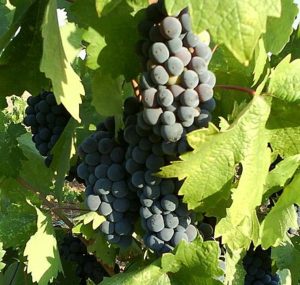 Zinfandel (also known as Primitivo) is a variety of black-skinned wine grape. The variety is grown in over 10% of California vineyards. DNA analysis has revealed that it is genetically equivalent to the Croatian grapes Crljenak Kaštelanski and Tribidrag, as well as to the Primitivo variety traditionally grown in Apulia (the “heel” of Italy), where it was introduced in the 18th century. The grape found its way to the United States in the mid-19th century, where it became known by variations of a name applied to a different grape, likely “Zierfandler” from Austria.
Zinfandel (also known as Primitivo) is a variety of black-skinned wine grape. The variety is grown in over 10% of California vineyards. DNA analysis has revealed that it is genetically equivalent to the Croatian grapes Crljenak Kaštelanski and Tribidrag, as well as to the Primitivo variety traditionally grown in Apulia (the “heel” of Italy), where it was introduced in the 18th century. The grape found its way to the United States in the mid-19th century, where it became known by variations of a name applied to a different grape, likely “Zierfandler” from Austria.
The grapes typically produce a robust red wine, although in the United States a semi-sweet rosé (blush-style) wine called White Zinfandel has six times the sales of the red wine. The grape’s high sugar content can be fermented into levels of alcohol exceeding 15%.
The taste of the red wine depends on the ripeness of the grapes from which it is made. Red berry fruit flavors like raspberry predominate in wines from cooler areas, whereas blackberry, anise, and pepper notes are more common in wines made in warmer areas and in wines made from the earlier-ripening Primitivo clone.
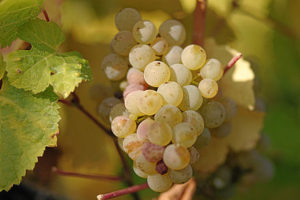 Riesling is a white grape variety which originated in the Rhine region. Riesling is an aromatic grape variety displaying flowery, almost perfumed, aromas as well as high acidity. It is used to make dry, semi-sweet, sweet, and sparkling white wines. Riesling wines are usually varietally pure and are seldom oaked. As of 2004, Riesling was estimated to be the world’s 20th most grown variety at 48,700 hectares (120,000 acres) (with an increasing trend), but in terms of importance for quality wines, it is usually included in the “top three” white wine varieties together with Chardonnay and Sauvignon blanc. Riesling is a variety which is highly “terroir-expressive,” meaning that the character of Riesling wines is greatly influenced by the wine’s place of origin.
Riesling is a white grape variety which originated in the Rhine region. Riesling is an aromatic grape variety displaying flowery, almost perfumed, aromas as well as high acidity. It is used to make dry, semi-sweet, sweet, and sparkling white wines. Riesling wines are usually varietally pure and are seldom oaked. As of 2004, Riesling was estimated to be the world’s 20th most grown variety at 48,700 hectares (120,000 acres) (with an increasing trend), but in terms of importance for quality wines, it is usually included in the “top three” white wine varieties together with Chardonnay and Sauvignon blanc. Riesling is a variety which is highly “terroir-expressive,” meaning that the character of Riesling wines is greatly influenced by the wine’s place of origin.
In cool climates (such as many German wine regions), Riesling wines tend to exhibit apple and tree fruit notes with noticeable levels of acidity that are sometimes balanced with residual sugar. A late-ripening variety that can develop more citrus and peach notes is grown in warmer climates (such as Alsace and parts of Austria). In Australia, Riesling is often noted for a characteristic lime note that tends to emerge in examples from the Clare Valley and Eden Valley in South Australia. Riesling’s naturally high acidity and pronounced fruit flavors give wines made from the grape exceptional aging potential, with well-made examples from favorable vintages often developing smokey, honey notes, and aged German Rieslings, in particular, taking on a “petrol” character.
In 2015, Riesling was the most grown variety in Germany with 23.0% and 23,596 hectares (58,310 acres), and in the French region of Alsace with 21.9% and 3,350 hectares (8,300 acres). In Germany, the variety is particularly widely planted in the Mosel, Rheingau, Nahe and Pfalz wine regions. There are also significant plantings of Riesling in Austria, Serbia, Czech Republic, Slovakia, Luxembourg, northern Italy, Australia, New Zealand, Canada, South Africa, China, Ukraine, and the United States (Washington, California, Michigan and New York).
Roussanne is a white wine grape grown originally in the Rhône wine region in France, where it is often blended with Marsanne. It is the only other white variety, besides Marsanne, allowed in the northern Rhône appellations of Crozes-Hermitage AOC, Hermitage AOC, and Saint-Joseph AOC. Roussanne is also planted in various wine-growing regions of the New World, such as California, Washington, Texas, and Australia, as well as European regions such as Crete, Tuscany, and Spain.
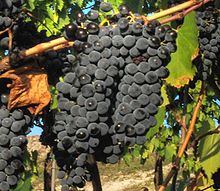 Sangiovese is a red Italian wine grape variety that derives its name from the Latin sanguis Jovis, “the blood of Jupiter.” Although it is the grape of most of central Italy from Romagna down to Lazio (the most widespread grape in Tuscany), Campania, and Sicily, outside Italy it is most famous as the only component of Brunello di Montalcino and Rosso di Montalcino and the main component of the blends Chianti, Carmignano, Vino Nobile di Montepulciano ,and Morellino di Scansano, although it can also be used to make varietal wines, such as Sangiovese di Romagna and the modern “Super Tuscan” wines like Tignanello.
Sangiovese is a red Italian wine grape variety that derives its name from the Latin sanguis Jovis, “the blood of Jupiter.” Although it is the grape of most of central Italy from Romagna down to Lazio (the most widespread grape in Tuscany), Campania, and Sicily, outside Italy it is most famous as the only component of Brunello di Montalcino and Rosso di Montalcino and the main component of the blends Chianti, Carmignano, Vino Nobile di Montepulciano ,and Morellino di Scansano, although it can also be used to make varietal wines, such as Sangiovese di Romagna and the modern “Super Tuscan” wines like Tignanello.
Sangiovese was already well known by the 16th century. Recent DNA profiling by José Vouillamoz of the Istituto Agrario di San Michele all’Adige suggests that Sangiovese’s ancestors are Ciliegiolo and Calabrese Montenuovo. The former is well known as an ancient variety in Tuscany, the latter is an almost-extinct relic from the Calabria, the toe of Italy. At least 14 Sangiovese clones exist, of which Brunello is one of the best regarded. An attempt to classify the clones into Sangiovese grosso (including Brunello) and Sangiovese piccolo families has gained little evidential support.
Young Sangiovese has fresh fruity flavours of strawberry and a little spiciness, but it readily takes on oaky, even tarry, flavours when aged in barrels. Although not as aromatic as other red wine varieties, such as Pinot noir, Cabernet Sauvignon, and Syrah, Sangiovese often has a flavour profile of sour red cherries with earthy aromas and tea leaf notes. Wines made from Sangiovese usually have medium-plus tannins and high acidity.
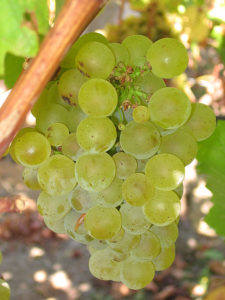 Sauvignon blanc is a green-skinned grape variety that originates from the Bordeaux region of France. The grape most likely gets its name from the French words sauvage (“wild”) and blanc (“white”) due to its early origins as an indigenous grape in South West France. It is possibly a descendant of Savagnin. Sauvignon blanc is planted in many of the world’s wine regions, producing a crisp, dry, and refreshing white varietal wine. The grape is also a component of the famous dessert wines from Sauternes and Barsac. Sauvignon blanc is widely cultivated in France, Chile, Romania, Canada, Australia, New Zealand, South Africa, the states of Washington and California in the US. Some New World Sauvignon blancs, particularly from California, may also be called “Fumé Blanc”, a marketing term coined by Robert Mondavi in reference to Pouilly-Fumé.
Sauvignon blanc is a green-skinned grape variety that originates from the Bordeaux region of France. The grape most likely gets its name from the French words sauvage (“wild”) and blanc (“white”) due to its early origins as an indigenous grape in South West France. It is possibly a descendant of Savagnin. Sauvignon blanc is planted in many of the world’s wine regions, producing a crisp, dry, and refreshing white varietal wine. The grape is also a component of the famous dessert wines from Sauternes and Barsac. Sauvignon blanc is widely cultivated in France, Chile, Romania, Canada, Australia, New Zealand, South Africa, the states of Washington and California in the US. Some New World Sauvignon blancs, particularly from California, may also be called “Fumé Blanc”, a marketing term coined by Robert Mondavi in reference to Pouilly-Fumé.
Depending on the climate, the flavor can range from aggressively grassy to sweetly tropical. In cooler climates, the grape has a tendency to produce wines with noticeable acidity and “green flavors” of grass, green bell peppers and nettles with some tropical fruit (such as passion fruit) and floral (such as elderflower) notes. In warmer climates, it can develop more tropical fruit notes but risk losing a lot of aromatics from over-ripeness, leaving only slight grapefruit and tree fruit (such as peach) notes.
Wine experts have used the phrase “crisp, elegant, and fresh” as a favorable description of Sauvignon blanc from the Loire Valley and New Zealand. Sauvignon blanc, when slightly chilled, pairs well with fish or cheese, particularly chèvre. It is also known as one of the few wines that can pair well with sushi.
Along with Riesling, Sauvignon blanc was one of the first fine wines to be bottled with a screwcap in commercial quantities, especially by New Zealand producers. The wine is usually consumed young, as it does not particularly benefit from aging, as varietal Sauvignon blancs tend to develop vegetal aromas reminiscent of peas and asparagus with extended aging. Dry and sweet white Bordeaux, including oak-aged examples from Pessac-Léognan and Graves, as well as some Loire wines from Pouilly-Fumé and Sancerre, are some of the few examples of Sauvignon blancs with aging potential.
The first Friday in May is International Sauvignon Blanc Day.
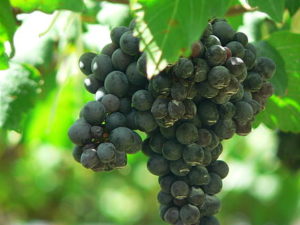 Syrah (/ˈsiːrɑː/), also known as Shiraz, is a dark-skinned grape variety grown throughout the world and used primarily to produce red wine. In 1999, Syrah was found to be the offspring of two obscure grapes from southeastern France, Dureza and Mondeuse Blanche. Syrah should not be confused with Petite Sirah, a cross of Syrah with Peloursin dating from 1880.
Syrah (/ˈsiːrɑː/), also known as Shiraz, is a dark-skinned grape variety grown throughout the world and used primarily to produce red wine. In 1999, Syrah was found to be the offspring of two obscure grapes from southeastern France, Dureza and Mondeuse Blanche. Syrah should not be confused with Petite Sirah, a cross of Syrah with Peloursin dating from 1880.
The style and flavor profile of wines made from Syrah is influenced by the climate where the grapes are grown with moderate climates (such as the northern Rhone Valley and parts of the Walla Walla AVA in Washington State) tending to produce medium to full-bodied wines with medium-plus to high levels of tannins and notes of blackberry, mint, and black pepper. In hot climates (such as Crete, and the Barossa Valley and McLaren Vale regions of Australia), Syrah is more consistently full-bodied with softer tannin, jammier fruit and spice notes of licorice, anise, and earthy leather. In many regions, the acidity and tannin levels of Syrah allow the wines produced to have favorable aging potential.
Syrah is used as a single varietal or as a blend. Following several years of strong planting, Syrah was estimated in 2004 to be the world’s 7th most grown grape at 142,600 hectares (352,000 acres). It can be found throughout the globe from France to New World wine regions such as: Chile, South Africa, the Hawke’s Bay, Waiheke, New Zealand, California, and Washington. It can also be found in several Australian wine regions, such as Barossa, Heathcote, Coonawarra, Hunter Valley, Margaret River, and McLaren Vale.
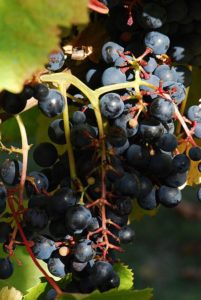 Tannat is a red wine grape, historically grown in South West France in the Madiran AOC, and is now one of the most prominent grapes in Uruguay, where it is considered the “national grape.” It is also grown in Argentina, Australia, Brazil, Bolivia, Peru, South Africa, and in the Italian region of Apulia, where it is used as a blending grape. In the U.S. states of Maryland and Virginia, there are small experimental plantings of the vine, and plantings in California have increased dramatically in the first years of the 21st century. It also shows great promise in Arizona and Oregon. Tannat wines produced in Uruguay are usually quite different in character from Madiran wines, being lighter in body and lower in tannins. It is also used to make Armagnac and full bodied rosé. In France, efforts to solve the harsh tannic nature of the grape led to the development of the winemaking technique known as micro-oxygenation.
Tannat is a red wine grape, historically grown in South West France in the Madiran AOC, and is now one of the most prominent grapes in Uruguay, where it is considered the “national grape.” It is also grown in Argentina, Australia, Brazil, Bolivia, Peru, South Africa, and in the Italian region of Apulia, where it is used as a blending grape. In the U.S. states of Maryland and Virginia, there are small experimental plantings of the vine, and plantings in California have increased dramatically in the first years of the 21st century. It also shows great promise in Arizona and Oregon. Tannat wines produced in Uruguay are usually quite different in character from Madiran wines, being lighter in body and lower in tannins. It is also used to make Armagnac and full bodied rosé. In France, efforts to solve the harsh tannic nature of the grape led to the development of the winemaking technique known as micro-oxygenation.
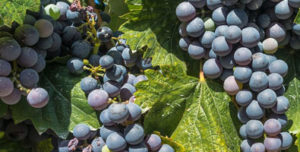 This Spanish grape is very new to Texas and is already showing great potential, especially in North Texas. The future for this variety in Texas appears to be bright.
This Spanish grape is very new to Texas and is already showing great potential, especially in North Texas. The future for this variety in Texas appears to be bright.
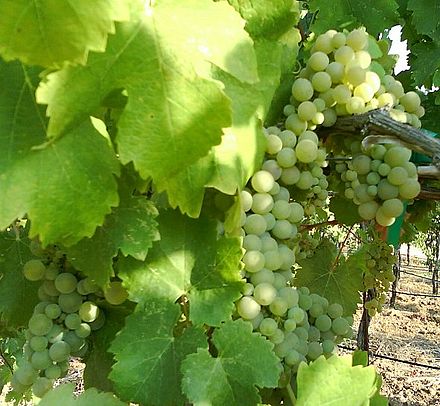 Viognier (French pronunciation: [viɔɲje]) is a white wine grape variety. It is the only permitted grape for the French wine Condrieu in the Rhône Valley. Outside of the Rhône, Viognier can be found in regions of North and South America as well as Australia, New Zealand, the Cape Winelands in South Africa and Israel. In some wine regions, the variety is co-fermented with the red wine grape Syrah where it can contribute to the color and bouquet of the wine.
Viognier (French pronunciation: [viɔɲje]) is a white wine grape variety. It is the only permitted grape for the French wine Condrieu in the Rhône Valley. Outside of the Rhône, Viognier can be found in regions of North and South America as well as Australia, New Zealand, the Cape Winelands in South Africa and Israel. In some wine regions, the variety is co-fermented with the red wine grape Syrah where it can contribute to the color and bouquet of the wine.
Like Chardonnay, Viognier has the potential to produce full-bodied wines with a lush, soft character. In contrast to Chardonnay, the Viognier varietal has more natural aromatics that include notes of peach, pears, violets, and minerality. However, these aromatic notes can be easily destroyed by too much exposure to oxygen, which makes barrel fermentation a winemaking technique that requires a high level of skill on the part of any winemaker working with this variety. The potential quality of Viognier is also highly dependent on viticultural practices and climate with the grape requiring a long, warm growing season in order to fully ripen but not a climate that is so hot that the grape develops high levels of sugars and potential alcohol before its aromatic notes can develop. The grape is naturally a low yielding variety, which can make it a less economically viable planting for some vineyards.
